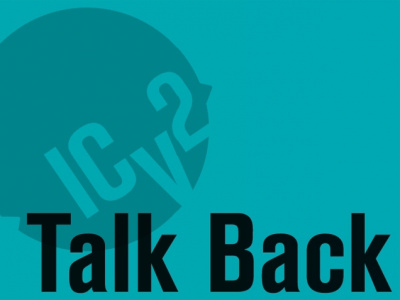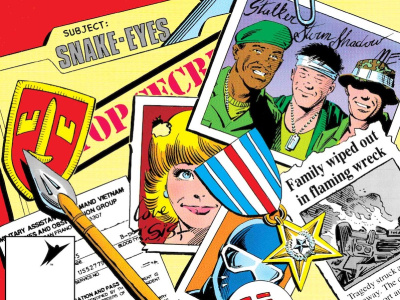Sharpening the Sword is a regular column by retailer John Riley of Grasshopper's Comics, a 1,300 square foot comic and games store in
I'd like to thank Buddy Saunders for his comments on the first part of this article. He's definitely right that we're at a point in our industry's history where there are openings for quite a few models of handling back issues, which is what I'm going to cover in this second half. Last week we looked at the way the back issue environment has changed from the point of views of the overall population of back issues and the habits of collectors. This week we'll look at two different factors: how this affects our business, and what new models might work well in this new environment.
With the changing back issue environment we discussed last week it becomes almost impossible for the average comic book shop to have a comprehensive selection of back issues. This is especially true when we start to consider Bronze Age books and earlier, which require significant effort to locate and keep in stock. But this is only part of the problem. In the past 15-18 years not only has the population of back issues exploded but the cost of store overhead has risen dramatically as well. In our area starting rent averaged around $12 a square foot fifteen years ago. Now, starting rent averages around $32 a square foot, plus any applicable common charges and taxes. And of course all our overhead has gone up in relation. Between taxes, insurance, utilities, shipping costs, etc... it just costs more to keep the same size store open than it did. While it might not be as dramatic in some more rural areas of the country, I don't think any of us have seen our costs of overhead come down in the past ten years.
The result is that stores need to average much higher sales per square foot. Now again, I'm not saying anything here that should surprise anyone. We all know this. But if that's the case, then why don't we view back issues the same way that we view other product lines? Generally speaking, we expect a good product line to turn somewhere around five times a year. Is there anyone anywhere who has a back issue turn rate of five?! Can you imagine that? I think the average back issue turn rate is probably closer to 1/10th. Even a back issue turn rate of 1 would be amazing! And of course if you factor in that most stores add back issues every year, that rate could probably be negative, you actually sell fewer books than you add.
So if we shoot for a turn rate of five in every other category in our store, why do we settle for far less in back issues? In one respect I think that there is simply an expectation on the part of customers to see back issues in the store. Although they may never buy any, they just think that a comic shop doesn't 'look like a comic shop' without bins of boxes to walk past every week on their way to the new issue wall. But expectations don't pay for that square footage occupied by those back issues!
We often justify this insanely poor turn rate to ourselves by saying that back issue sales are 'all profit' since they've already been paid for (in financial terms this is called a 'sunk cost'). But that's actually not really true. After all, we usually invest in bags and boards for our back issues. And consider that most of the back issues we bag and board won't sell, meaning those that do sell have to pay for the bags and boards on the books that are permanently sitting there. Also having someone sort, bag and board, and put away all those back issues costs something. Even if you're doing it yourself it will cost you your time. And let's not forget that stores are expected to pay taxes on any extra inventory they carry at the end of the year, which is considered profit for tax purposes. Since most of us have more back issues at the end of each year, you are expected to pay income tax on the 'profit' sitting in your back issue bin.
I think one of the biggest reason for the continued presence of back issues in most stores is that most of us just hate to lose money on anything! Hey, we paid for it, we'd like to at least get our money back, right? But really, as a business model, does it make a lot of sense? Consider this, when the book was new it didn't sell. But now that it's left over and past its prime selling window, we invest more money (bags and boards), resources (employee's time) and overhead (floor space) into keeping it on display...and raise the price!
This situation might apply to most of us, but it certainly doesn't apply to everyone and in that way presents opportunities for different models of selling back issues to arise. The most obvious of which is the one that Buddy has set up with Lone Star, creating a Website to sell a massive centralized inventory to the broadest customer base possible. Since he's 'selling to the planet,' he can afford to invest in a large facility and a very heavy inventory position. We've already seen this approach in action and there are other players still entering the field.
Another model might consist of doing the same thing in a very large, low cost location and serving as a 'regional hub' for back issues. In this way a store that might be able to stock and display a few hundred thousand back issues might become a destination store to buy/sell for a much wider geographic area than the normal store could ever draw from.
Other stores might decide to specialize in a certain type, genre, or era of back issue. Stores might want to specialize in just Silver or Golden Age books. Or perhaps they would specialize in having independent publishers, or an incredibly comprehensive selection of recent back issues. These are just a few areas where stores could reasonably focus their energies and possibly generate interest and sales from beyond their own customer base.
So what did we do? Well, we decided to pretty much eliminate back issues entirely. Now before anyone condemns me for that decision let me give you a little background. At our peak a few years back we had about 100 long boxes, or somewhere around 22,000 comics, on our sales floor (a considerable use of floor space considering we're a little under 1,300 square feet including in-store gaming space). But we found that the overwhelming majority of our customers didn't buy back issues, although a small percentage would if they were on sale (our back issues were all cover price when not on sale). Over the past three years we also realized that the overwhelming majority of our back issue sales were books from the past 6-18 months. Essentially, people were primarily catching up on series that they might have missed.
Running some numbers we found that although our back issues took up twice as much space as our trade paperbacks, they amounted to only 5% of our trade paperback sales. For us, they just weren't generating enough revenue to justify their square footage. We obviously had interest in older stories, but those sales were coming in the form of trade paperbacks. Our solution was to eliminate traditional back issue bins, and create displays of 'back issues' from the last 18 months for series that were currently still being released. In that way, we were able to better display the books that people were actually interested in, and save space for products with higher demand. Of course, this is not a solution I would recommend to everyone, but for us it met our needs and the needs of our customers. Perhaps back issues are a very important sales category in your store, but if they're not then carrying a huge selection of them simply for appearance sake may not be a financially sound decision.
This was a very scary conversion for us, and one we implemented gradually over the past two years. I trembled taking the last bin apart two months ago and wondered what the reaction would be to a store with no back issues. The result so far? Nobody's really noticed they were gone, but they all complimented us on the great new comics display!
The opinions expressed in this Talk Back article are solely those of the writer, and do not necessarily reflect the views of the editorial staff of ICv2.com.







